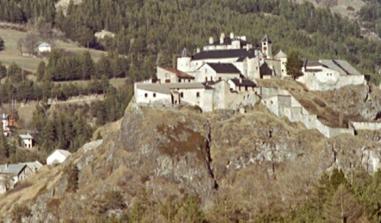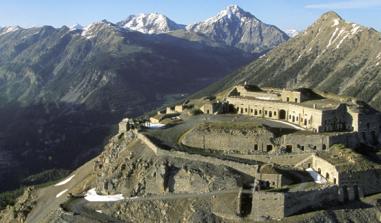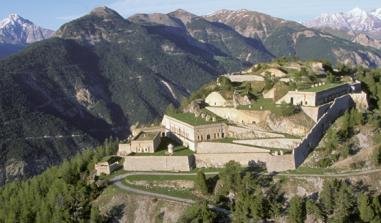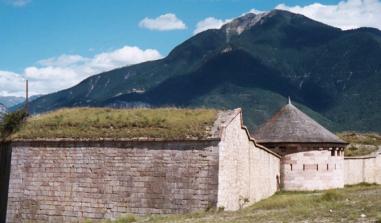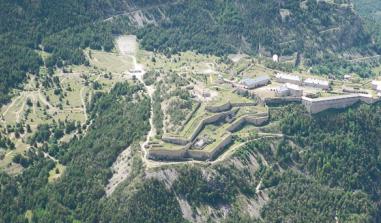The redoubt of les Salettes
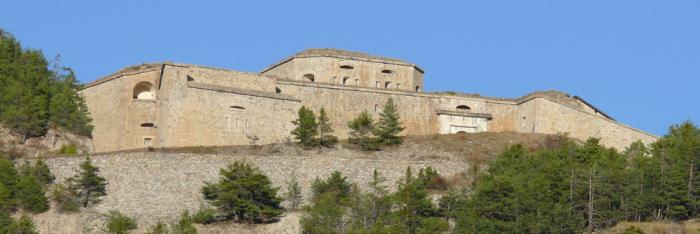
Fort des Salettes vu de Briançon. Source : ©MOSSOT - License Creative Commons - Libre de droit
Designed by Vauban after his first visit in 1692, it is situated above the high town on the first of the twisting roads that lead to the Croix de Toulouse.
The town of Briançon, a stronghold on the Durance, did not escape Marshal de Vauban's wisdom. He endowed the town with a citadel and fortified it by installing defence positions on the hills, such as the redoubt of les Salettes which started a tradition of fortification that would see the installation of new defence structures at up to 2,500 m during the 19th and 20th centuries.
Vauban in Briançon: fortifying the town "in a modern way". Fortification project in 1692. The site appeared a difficult one for him to develop, as it was surrounded on all sides by high hills: "You can't imagine anywhere more uneven, with mountains reaching up to the skies and valleys descending into the abyss..." (Vauban in 1692). The town was already protected by a crude wall, built by resident engineer Hue de Langrune between 1689 and 1691. Closely resembling a medieval curtain wall, it had no external fortifications. In his eyes "as the town's new wall was built with a view to protecting it from the affronts of the Barbets and not to withstand a well-planned siege...", there was still everything to do. On the 21st November 1692, he drew up his project for the fortifications to be built in the town and at the château of Briançon. He requested the construction of two demi-lunes, as well as a false bray on the Embrun front. This structure, necessary because of the steep incline, is a kind of step set below the bastioned trace, which provides the potential for more effective grazing fire. He stipulated various developments: the deepening of the moats, the consolidation of the curtain walls, the installation of guard houses, the creation of port holes, traverses and posterns, the vaulting of the gate and the construction of powder stores. To spare the residents from having to provide accommodation for the soldiers, he planned the construction of barracks. Vauban was also concerned about the problem of providing water, as all the sources supplying the town came from outside. He requested the deepening of the well in the Place d'Armes. Vauban considered a significant project for the château, but then abandoned it. On the one hand he feared he would not obtain the necessary funding and on the other, Briançon, although far from the border, was already protected by other strongholds.
Controlling the progress of the work and adapting the projects. Memo of 1700. During his second trip to Briançon, Vauban inspected the work and released a new memo, dated the 24th August 1700, taking into account the loss of the stronghold at Pignerol: "The significance of this place has greatly increased since the destruction of Pignerol" (Vauban in 1700). He envisaged an enlargement of the town under the Embrun gateway, in order to house all the military buildings, as the small size of the town did not allow it to be built within the ramparts (a project that was not followed up). He recommended the erection of a bridge over the Durance, the creation of a road to Montgenèvre, the occupation of the Plateau des Têtes and the construction of a redoubt on the Montagne des Salettes. He drew up 99 articles about the château before finally concluding "that it would be far better to totally demolish this bad old dinosaur... and rebuild everything from scratch". The slow progress of the work led local engineers to take the liberty of making alterations, which enraged Vauban, in particular the project for a counterguard, about which he wrote in 1704: "I see a kind of false bray or covered walkway... which up to now has not been mentioned in the overall project... I note with surprise that Lord Guillyn has taken great delight in adding, removing and altering whatever he likes... if I was younger I would offer to go there from time to time and put it all right ."
Securing the hills Projects for the château Vauban gave this description of the château de Briançon during his first trip in 1692: "The château sits on a high, naturally steep rock above the town, ..., its old enclosure is only two and a half feet thick and is not even terraced... the four towers are quite good (...) in the château (...) there is only one old large square tower with three floors that are used as stores and an arsenal, (...) a guardhouse, a small water tank in poor condition, two or three old outbuildings about to fall into ruin, ten old and six modern barrack rooms, practically no well or latrines and a very poor gate that has neither tread boards nor a drawbridge..." Vauban thus strengthened the existing structure and ordered improvements: a second water tank, latrines and basements.
The redoubt of les Salettes In his first project, Vauban suggested the creation of a machicolated redoubt on the Montagne du Poët. The structure was designed to prevent the enemy from taking this town with its important commanding position over the town and the château. It is highly likely that Vauban took up a suggestion of the engineer Delabat dating from January 1692. In February 1704, he complained that work had not yet begun. It would not start until 1709, two years after Vauban's death, under the supervision of the engineer Tardif and would continue until 1712. The fort looks like a reduced tower, surrounded by a moat and a counterscarp with a reverse fire gallery. Its uniqueness is in the fact that access to the gallery is only possible via a basement leading from the reduit. The tower itself is a square building with graduated sides, on two levels, covered with a pyramid shaped roof. Access is via the first floor across a footbridge over the moat. The barrel-vaulted reverse fire gallery prevented the enemy from breaching the interior moat. Under the reign of Juillet, this redoubt would be converted into a fort by the addition of a bastioned outer defence line (envelope), six Haxo-type casemates and a powder store. The tower would be reinforced with a terraced roof and better equipped with artillery. Continuing Vauban's work: protecting the new border. The end of the reign of Louis XIV was marked by the war of the Spanish Succession from 1701 to 1714, when, once again, France was in conflict with part of Europe. The Briançon area became a place of confrontation between the French and the Savoyards. In 1713, the Treaty of Utrecht brought an end to some of the hostilities. Unfortunately, it turned out to be disastrous for the land of the Escartons. The border, which up until then had been well beyond the mountains, was moved to the watershed in the Montgenèvre pass. France lost Val Cluson, la Varaïta and part of the Val de Suse, receiving in exchange the Ubaye. The town thus became a border zone which required protection. The construction of a veritable barrier of forts began under the Regency in July 1721 and continued for thirteen summers under the reign of Louis XV. Claude François Bidal, Marquis Marshal of Asfeld, a follower and the successor of Vauban, would be in charge of the work as Director General of the fortifications of France. As reinforcements for the fortifications of the town and of the redoubt of les Salettes, seven "Vauban style" fortifications would be built around the town: the Trois-Têtes, Randouillet, Dauphin, and Anjou forts, the Point du Jour redoubt, Communication Y and the Asfeld Bridge.
The redoubt of les Salettes Route de l'Italie 05100 Briançon Tel.: + 33 (0) 4 92 21 08 50 Fax : + 33 (0) 4 92 20 56 45 Guided tours are provided by lecturers from the heritage department Town of Briançon - Heritage Department Porte de Pignerol 05100 Briançon Tel: + 33 (0) 4 92 20 29 49 Fax: + 33 (0) 4 92 20 39 84 E-mail: patrimoine@mairie-briancon.fr The Club du Vieux Manoir restores and hosts activities during the summer season in the Forts of les Salettes and the Château, which belong to the town. The ancient Abbey du Moncel 60700 Pontpoint Tel: + 33 (0) 3 44 72 33 98
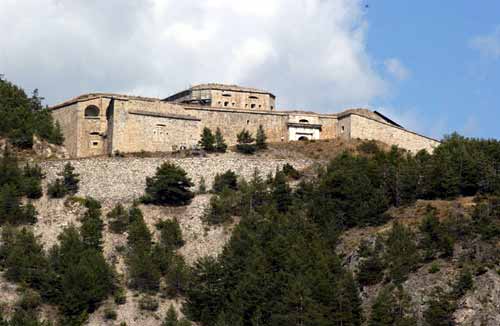
The fort des Salettes. Source: ECPAD
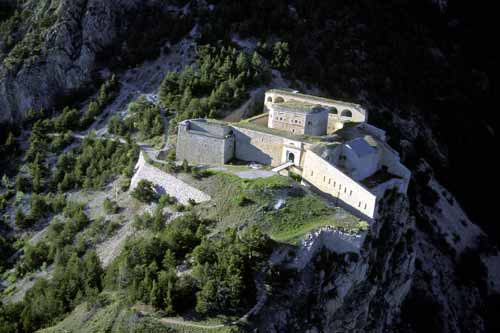
The fort des Salettes. Source: ECPAD
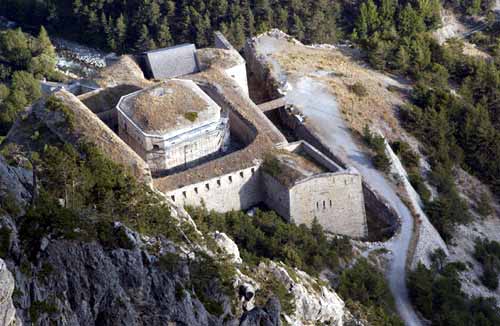
The fort des Salettes. Source: ECPAD
Practical information
5100
Briançon
04 92 21 08 50
Plein tarif: 6-7 € Tarif réduit: 4,50-5,50 € Gratuit : Enfant de moins de 12 ans
Du 18 au 30 juin et du 1er au 18 septembre: le mercredi, jeudi et vendredi de 11h à 18h. Du 1°Juillet au 31 Août: tout les jours sauf le dimanche, de 11h à 18h
Fermé du 18 septembre au 18 juin





